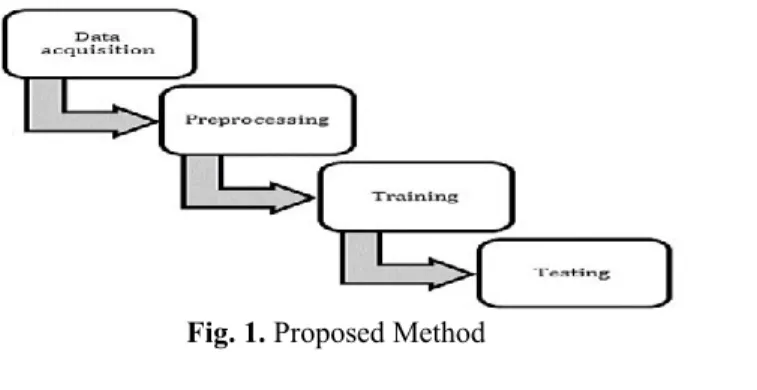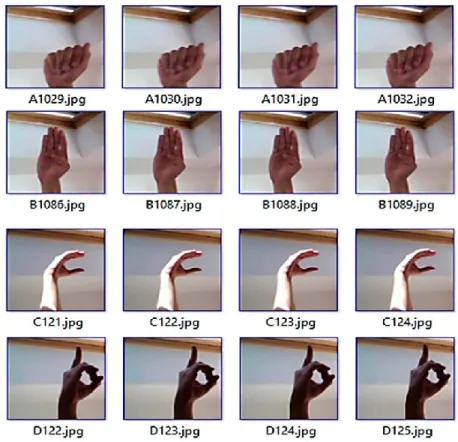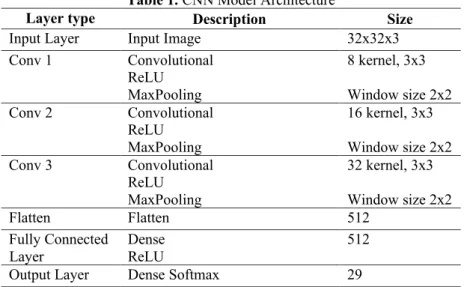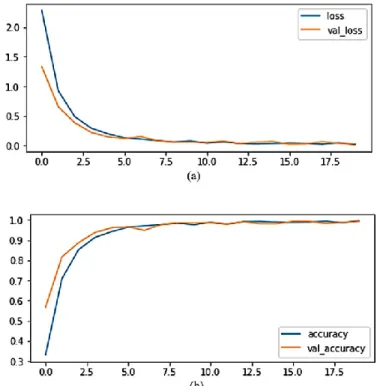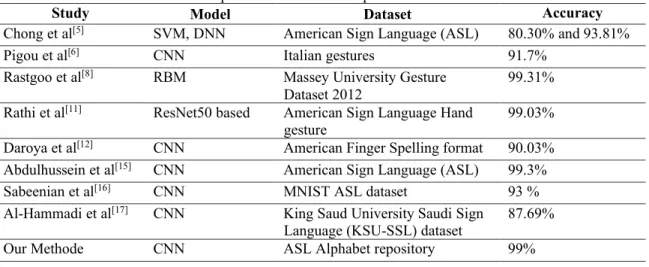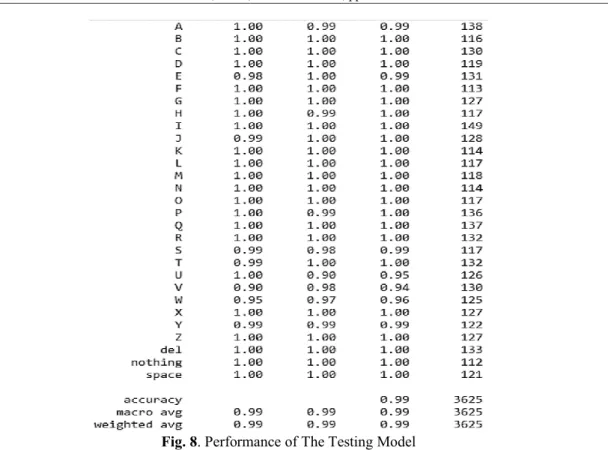Journal Ilmiah Teknik Elektro Komputer en Informatika http://journal.uad.ac.id/index.php/JITEKI. Please write the research contribution in the last part of the Introduction, such as "The research contribution is...." There are at least two research contributions. Chin, "The Development of Real-Time Mobile Garbage Detection Using Deep Learning," Journal Ilmiah Teknik Elektro Komputer en Informatika, vol.
Jurnal Ilmiah Teknik Elektro Komputer dan Informatika http://journal.uad.ac.id/index.php/JITEKI. Chin, "Pengembangan Deteksi Sampah Mobile Real-Time Menggunakan Deep Learning," Jurnal Ilmiah Teknik Elektro dan Informatika Komputer, vol. Anda tidak akan pernah tertarik untuk mempelajari Jurnal Ilmiah Teknik Elektro Komputer dan Informatika, "Deep Learning Approach For Sign Language Recognition".
Journal homepage: http://journal.uad.ac.id/index.php/JITEKI Email: [email protected].
INTRODUCTION
Sign language is a method of communication using hand gestures among people with hearing loss. This study aims to create a hand sign language recognition model for alphabetic letters using a deep learning approach. The main contribution of this research is to produce a real-time sign language image acquisition and sign language recognition model for Alphabet.
Finally, the process of testing the model using manual sign language image data input from a webcam. Researchers [5] proposed a language recognition system using a 3D motion sensor using k-nearest neighbor and support vector machine (SVM) to classify 26 letters in sign language. While the study [10] proposed a Restricted Boltzmann Machine (RBM) for automatic manual sign language recognition from visual data.
In [11], they proposed a deep learning-based framework for analyzing video features (images and optical flow) and skeletons (body, hands, and faces) using two sign language datasets. The model was evaluated against a continuous Chinese sign language benchmark with better performance. The dataset used is the standard American Sign Language hand gesture, which provides an accuracy of 99.03%.
While the study of [14] Densely Connected Convolutional Neural Network (DenseNet) classifies sign language in real-time using a web camera with an accuracy of 90.3%. Based on previous related studies, most sign language recognition methods use a deep learning approach. Second, build a manual sign language recognition model for the Alphabet using a seven-layer CNN trained using the ASL dataset and applying resizing and background correction of the input image.
METHOD
The average results of the highest classification levels of 72.78% and 79.83% were achieved by k-nearest neighbors and support vector machines, respectively. Based on previous studies that proposed hand sign language recognition models for alphabets, the results were not optimal, this is due to the complexity of lighting factors and other objects appearing in hand gesture images [5]. While there have been many studies on sign language recognition using a deep learning approach, here are some related studies including Study [8] has proposed a recognition system using a convolutional neural network (CNN) that can recognize 20 Italian gestures with high accuracy.
A continuous deep learning-based sign language recognition model was also introduced [12] which proposed a 3D convolution residual network architecture and bidirectional LSTM, as a grammatical rule-based classification problem. This study focuses on the introduction of hand sign language from the letters of the alphabet, which is used as a means of communication with the deaf. At this stage, the image size transformation is performed to reduce the complexity of the model architecture.
In this study, the image size transformation of the training data images from the original size of 200x200 pixels was changed to 32x32 pixels. To improve the segmentation accuracy of the sign language image below for complex lighting conditions, we apply a background correction method with luminance separation correction and adaptive thresholding [25][26]. In this study, we use hyperparameter tuning to control the behavior of the machine learning model to produce optimal results.
27][28], then the training of the model will be done using the dataset from manual sign language image preprocessing. At this stage, the model will be tested with real-time hand sign language images using a web camera. In addition, the results will be measured using a confusion matrix to determine the performance of the model [29].
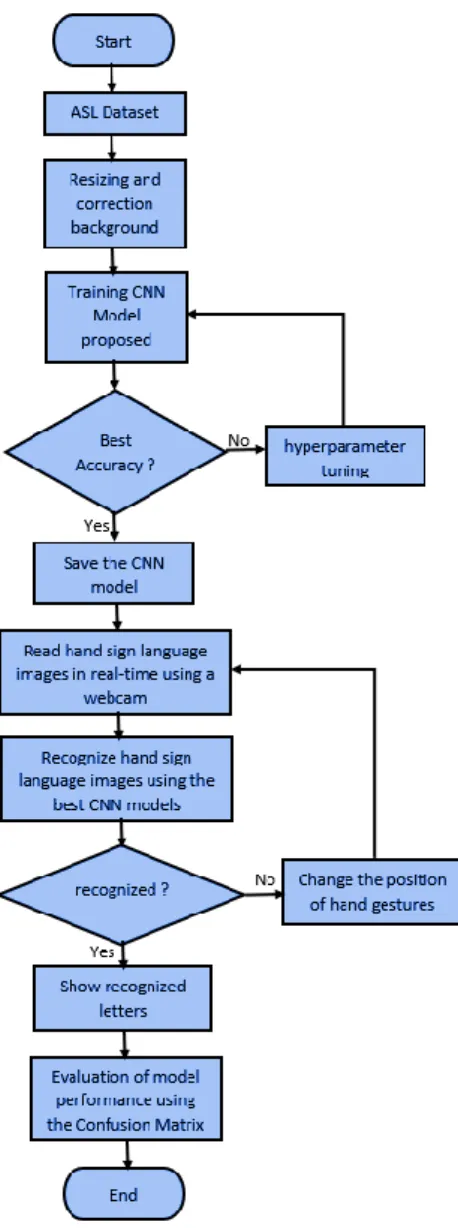
Training
At this stage, the CNN model design used in the training process is performed to produce a suitable model to classify hand sign language images. The CNN model used uses hyperparameter values consisting of learning rate, epoch, loss function and optimization. The architectural design of the CNN is as shown in Table 1, there are input layers, 3 convolutional layers, flat, fully connected layers and output layers.
The training process will be performed through a series of iterations whose number of iterations is determined by the maximum epoch value [36]. While the hyperparameter used in this study is the Adam Optimizer [37] with The Batch Size is 32 and Epochs is 20. The model training process is performed in a hardware and software environment with specifications for Dell Latitude E7440 Laptop, 12 GB DDR4 RAM, Processor Intel® Core™ i5-7200U CPU @ 2.50GHz, Nvidia GeForce 940MX GPU, 256 GB SSD.
The operating system used is Windows 10 Professional and the training and testing model algorithms are implemented using python code using the Tensorflow library. Process graphs of the training model: (a) Training loss and validation, (b) training accuracy and validation.
Testing
The main result of this research is that the use of sizing and background correction methods as well as hyperparameter tuning can improve model accuracy. 6, the test process is performed by entering input in the form of hand signals via the web camera on the laptop, where the hand makes a hand movement in the region of interest box on the web cam display. Then the webcam display shows the alphabetical prediction of the hand signal along with the score on the board.
Model testing is performed for each letter 10 times, i.e. a total of 290 times of testing. 8 Show the value of the confusion matrix from the model testing results for 29 types of sign language for each letter of the alphabet. This is because we are resizing and correcting the background for the training and test images.
The results of this study suggest that this sign language recognition model can be a sign language independent learning tool with a relatively better level of recognition accuracy than previous similar studies. The strength of this study is that the proposed hand sign language recognition model can perform hand sign language recognition from the alphabet in real time. While the limitation of this model is that the performance of the model is heavily influenced by the specifications of the webcam and the lighting system.
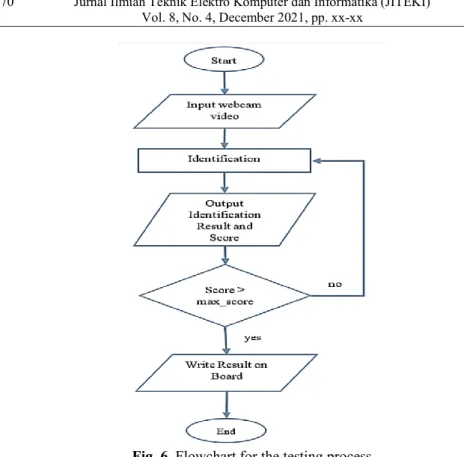
CONCLUSION
Our next work is to add to the sign language dataset basic words in addition to letters of the alphabet, as well as to increase the accuracy of the model by adding other hyperparameters. Bhuiyan, "Bengali Sign Language Recognition Using Deep Convolutional Neural Network", in 2018 7th International Joint Conference on Computing, Electronics and Vision and 2nd International Conference on Image, Vision and Pattern Recognition, ICIEV-IVPR no. Lee, “American sign language recognition using dance motion controller with machine learning approach,” Sensors (Switzerland), vol.
Schrauwen, “Sign Language Recognition Using Convolutional Neural Networks,” in European Conference on Computer Vision, 2014, pp. Aktaruzzaman, “A new benchmark on american sign language recognition using convolutional neural network,” in 2019 International Conference on Sustainable Technologies for Industry 40. , SOI nr. Raheem, "Handgebareherkenning van statiese letters Amerikaanse gebaretaal (ASL) met behulp van diep leer," Eng.
Al-Hammadi et al., “Deep learning-based approach for sign language gesture recognition with efficient hand gesture representation,” IEEE Access, vol. Zhang, “Feature fusion of convolutional neural network weighted and graph attention network for hyperspectral image classification,” IEEE Trans. Zhou, “Automatic crop/background segmentation based on luminance split correction and adaptive thresholding,” IEEE Access , vol.
Morgado-Dias, “Convolutional neural network multi-objective hyperparameter optimization for obstructive sleep apnea detection,” IEEE Access, vol. Budiarto, “Evaluation of Confidence and Confusion Matrix Prediction Measures for Web Service Ranking,” IEEE Access, vol. Abulaish, and Jahiruddin, “Multi-label classification of microblogging texts using convolution neural network,” IEEE Access, vol.
Revision results
Comment of Editor
The table must be made using the Insert Table feature not from the clipping table as an image. We suggest using 3 columns of the table to help and then doing the equation in the middle of the column and the equation number in the right column. Please see the guide in the link on how to make the equation in question and provide the equation number.
We also used the 3 column table to create the equations and listed the equation in the middle column and the number of the equation in the right column. All figures, tables and equations should be quoted and explained in paragraphs; provide some explanation, information or analysis. All figures and tables must be given through some analysis in at least one paragraph.
All figures and tables were given with an analysis in at least one paragraph. Please use the journal template and make sure the percentage of plagiarism is below 25%, otherwise the manuscript will be rejected.
Comment of Reviewers
Based on the background, this study aims to develop a sign language recognition model for the letters of the alphabet using a deep learning approach. This research is a quantitative experimental research to measure the performance of manual sign language recognition models based on training datasets. The purpose of this study is to build a manual sign language introduction model using a deep learning approach.
